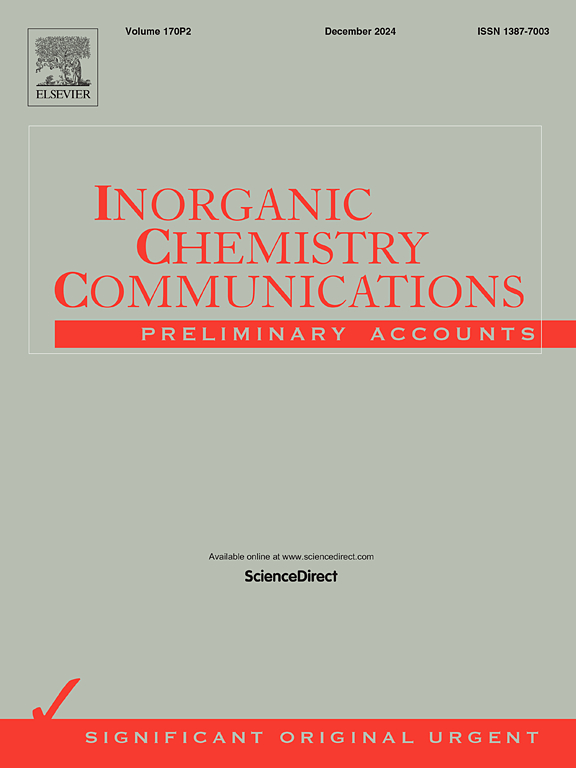Anticorrosive polyaniline-beetroot extract iron oxide (Fe2O3) nanocomposites to improve electromagnetic interference shielding capability
IF 4.4
3区 化学
Q1 CHEMISTRY, INORGANIC & NUCLEAR
引用次数: 0
Abstract
This paper presents, the development of highly flexible and functionally intact, sustainable electromagnetic interference (EMI) shielding materials routed through plant extract species. Polyaniline-beetroot extract iron oxide (Fe2O3) nanocomposite material with corrosion inhibition characteristics for broadband electromagnetic interference (EMI) shielding in the 8–12 GHz (X-band) range was evaluated. UV–Visible, FT-IR, XRD, SEM and DLS techniques were employed to examine the composite’s physicochemical characteristics. Transmission line waveguide technique employed for EMI shielding analysis showed that, with a low thickness of 3 mm at the 8–12 GHz frequency range, composite samples have shown remarkable shielding effectiveness (SE) of −12.17 dB to −17.5 dB. Polyaniline (PANI)-filler compatibility with contributed dielectric and magnetic qualities of the filler within the PANI matrix was very optimal for the observed higher electromagnetic wave attenuation ability throughout the broad frequency range. Further, the anticorrosion property of polymer nanocomposite on mild steel (MS) in 5 M HCl solution confirmed by atomic absorption spectroscopy (AAS) scanning electron microscopy (SEM) and Monte Carlo (MC) simulation studies. These findings suggest that, high-performance, multifunctional conducting polymer-based EMI shielding materials could be made through the incorporation of plant extract species resulting modified and exceptional magnetic and electrical properties.

抗腐蚀聚苯胺-甜菜根提取物氧化铁(Fe2O3)纳米复合材料提高电磁干扰屏蔽能力
本文介绍了利用植物提取物制备高柔性、功能完整、可持续的电磁干扰屏蔽材料的研究进展。研究了聚苯胺-甜菜根提取物氧化铁(Fe2O3)纳米复合材料在8-12 GHz (x波段)宽带电磁干扰(EMI)屏蔽中的缓蚀性能。采用UV-Visible、FT-IR、XRD、SEM和DLS等技术对复合材料的理化性质进行了表征。采用传输线波导技术进行电磁干扰屏蔽分析表明,在8-12 GHz频率范围内,低厚度3 mm的复合材料样品具有显著的屏蔽效果(SE),为−12.17 dB ~−17.5 dB。聚苯胺(PANI)填料与聚苯胺基体内填料的介电和磁性的相容性非常好,在很宽的频率范围内具有较高的电磁波衰减能力。此外,通过原子吸收光谱(AAS)、扫描电镜(SEM)和蒙特卡罗(MC)模拟研究证实了聚合物纳米复合材料对低碳钢(MS)在5 M HCl溶液中的防腐性能。这些发现表明,高性能、多功能的导电聚合物基电磁干扰屏蔽材料可以通过加入植物提取物来获得改良的和特殊的磁性和电学性能。
本文章由计算机程序翻译,如有差异,请以英文原文为准。
求助全文
约1分钟内获得全文
求助全文
来源期刊

Inorganic Chemistry Communications
化学-无机化学与核化学
CiteScore
5.50
自引率
7.90%
发文量
1013
审稿时长
53 days
期刊介绍:
Launched in January 1998, Inorganic Chemistry Communications is an international journal dedicated to the rapid publication of short communications in the major areas of inorganic, organometallic and supramolecular chemistry. Topics include synthetic and reaction chemistry, kinetics and mechanisms of reactions, bioinorganic chemistry, photochemistry and the use of metal and organometallic compounds in stoichiometric and catalytic synthesis or organic compounds.
 求助内容:
求助内容: 应助结果提醒方式:
应助结果提醒方式:


